Some of the information on this Web page has been provided by external sources. The Government of Canada is not responsible for the accuracy, reliability or currency of the information supplied by external sources. Users wishing to rely upon this information should consult directly with the source of the information. Content provided by external sources is not subject to official languages, privacy and accessibility requirements.
Any discrepancies in the text and image of the Claims and Abstract are due to differing posting times. Text of the Claims and Abstract are posted:
| (12) Patent Application: | (11) CA 2714020 |
|---|---|
| (54) English Title: | A LID FOR VACUUM-SEALING PACKAGING AND THE MANUFACTURING PROCESS THEREOF |
| (54) French Title: | COUVERCLE POUR EMBALLAGE A SCELLEMENT SOUS VIDE ET SON PROCEDE DE FABRICATION |
| Status: | Deemed Abandoned and Beyond the Period of Reinstatement - Pending Response to Notice of Disregarded Communication |
| (51) International Patent Classification (IPC): |
|
|---|---|
| (72) Inventors : |
|
| (73) Owners : |
|
| (71) Applicants : |
|
| (74) Agent: | NELLIGAN O'BRIEN PAYNE LLP |
| (74) Associate agent: | |
| (45) Issued: | |
| (86) PCT Filing Date: | 2008-09-19 |
| (87) Open to Public Inspection: | 2009-08-20 |
| Examination requested: | 2010-09-13 |
| Availability of licence: | N/A |
| Dedicated to the Public: | N/A |
| (25) Language of filing: | English |
| Patent Cooperation Treaty (PCT): | Yes |
|---|---|
| (86) PCT Filing Number: | PCT/BR2008/000306 |
| (87) International Publication Number: | WO 2009100507 |
| (85) National Entry: | 2010-08-03 |
| (30) Application Priority Data: | ||||||
|---|---|---|---|---|---|---|
|
A lid for vacuum-sealing packaging, which comprises a lid (10) with a film
(20) hermetically seated against and retained
in the inner surface, said film (20) ensuring the closing of the pass-through
hole (11), thus eliminating the need for
varnishing the inner surface of the lid and of the release hole.
L'invention porte sur un couvercle pour emballage à scellement sous vide, qui comprend un couvercle (10) avec un film (20) appuyé de façon hermétique contre la surface interne et maintenu dans celle-ci, ledit film (20) assurant la fermeture du trou traversant (11), de façon à éliminer ainsi la nécessité de vernir la surface interne du couvercle et du trou de libération.
Note: Claims are shown in the official language in which they were submitted.
Note: Descriptions are shown in the official language in which they were submitted.

2024-08-01:As part of the Next Generation Patents (NGP) transition, the Canadian Patents Database (CPD) now contains a more detailed Event History, which replicates the Event Log of our new back-office solution.
Please note that "Inactive:" events refers to events no longer in use in our new back-office solution.
For a clearer understanding of the status of the application/patent presented on this page, the site Disclaimer , as well as the definitions for Patent , Event History , Maintenance Fee and Payment History should be consulted.
| Description | Date |
|---|---|
| Application Not Reinstated by Deadline | 2013-09-19 |
| Time Limit for Reversal Expired | 2013-09-19 |
| Inactive: Abandoned - No reply to s.30(2) Rules requisition | 2013-01-09 |
| Deemed Abandoned - Failure to Respond to Maintenance Fee Notice | 2012-09-19 |
| Inactive: S.30(2) Rules - Examiner requisition | 2012-07-09 |
| Amendment Received - Voluntary Amendment | 2012-03-14 |
| Amendment Received - Voluntary Amendment | 2012-03-01 |
| Inactive: S.30(2) Rules - Examiner requisition | 2011-09-09 |
| Inactive: Cover page published | 2010-11-04 |
| Inactive: Notice - National entry - No RFE | 2010-09-27 |
| Application Received - PCT | 2010-09-27 |
| Inactive: First IPC assigned | 2010-09-27 |
| Inactive: IPC assigned | 2010-09-27 |
| Inactive: IPC assigned | 2010-09-27 |
| Letter Sent | 2010-09-27 |
| Request for Examination Received | 2010-09-13 |
| Request for Examination Requirements Determined Compliant | 2010-09-13 |
| All Requirements for Examination Determined Compliant | 2010-09-13 |
| Request for Examination Received | 2010-09-13 |
| National Entry Requirements Determined Compliant | 2010-08-03 |
| Small Entity Declaration Determined Compliant | 2010-08-03 |
| Application Published (Open to Public Inspection) | 2009-08-20 |
| Abandonment Date | Reason | Reinstatement Date |
|---|---|---|
| 2012-09-19 |
The last payment was received on 2011-09-01
Note : If the full payment has not been received on or before the date indicated, a further fee may be required which may be one of the following
Please refer to the CIPO Patent Fees web page to see all current fee amounts.
| Fee Type | Anniversary Year | Due Date | Paid Date |
|---|---|---|---|
| Basic national fee - small | 2010-08-03 | ||
| Request for examination - small | 2010-09-13 | ||
| MF (application, 2nd anniv.) - small | 02 | 2010-09-20 | 2010-09-13 |
| MF (application, 3rd anniv.) - small | 03 | 2011-09-19 | 2011-09-01 |
Note: Records showing the ownership history in alphabetical order.
| Current Owners on Record |
|---|
| INDUSTRIAS REUNIDAS RENDA S.A. |
| Past Owners on Record |
|---|
| EDUARDO JOSE RENDA |